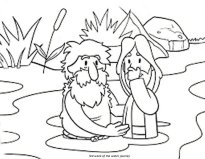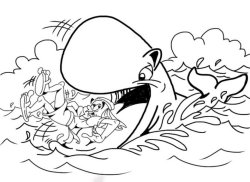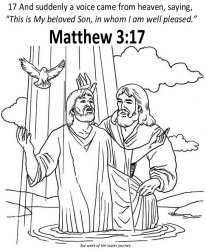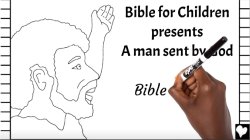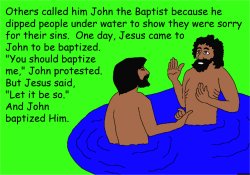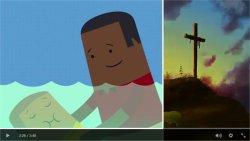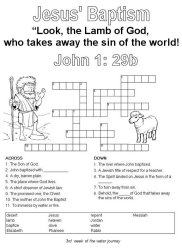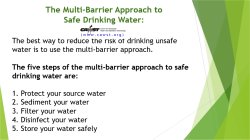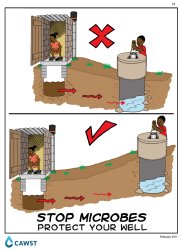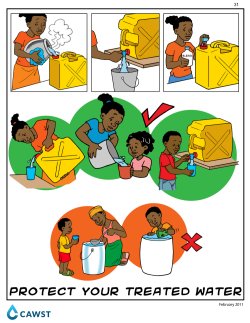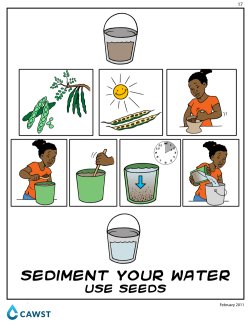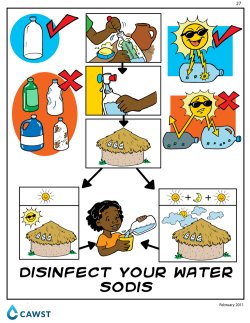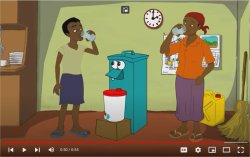
|
 Contact UsGrow and Go TrainingGrow and Go curriculumGrow and Go Water Series
Child EvangelismDrop of Hope BioSand Filters
Countries SelectedFood For LifeHumanitarian ArmMore UCT Curriculum |
home >>light >> water >> session 3>> session 4
Grow and Go - Water Series - Session #4 This week’s destination: JESUS’ WATER BAPTISMMATERIALS: Print Sports Symbols. Balloons. Photocopy Colouring pages, quizzes and crosswords. Print Bible Verse Visual Aid. Blue cloth, Jesus outfit, (white and blue wraps) John's outfit (black and green wraps) Dove template, Roll of paper, chair.
AS KIDS ARRIVE PRIOR TO THE LESSON: 1. WELCOME GAME: (10 minutes) 2. TEAM GAMES: (10 minutes) 2. TEAM GAMES: (10 minutes)
|
Prayer: Father we thank you that although Jesus never sinned, He saw it fit to follow God’s plan for man by being baptized in water so that He could be an example to man. Thank you Jesus for humbling yourself and allowing John to baptize you. We know God that you are pleased with us when we obey You – thank you Holy Spirit for helping us to become obedient to God in the same way the dove came upon Jesus and God said He loved Him and was delighted in Him, let our lives be a delight to You.
(Read Matthew 3: 13-17 - Dramatize the Bible reading (NKJV) Preparation: Get two volunteers to hold the blue cloth at each corner about 3 foot off the ground. John will lower Jesus below the ‘water’ and as He comes out Jesus will raise His hands to Heaven and the child with the dove will hold it above His head, and God ‘s voice then thunders out. “This is my Son, whom I love; with him I am well pleased.”
c. Teach the Lesson Download Session #4 Visual Aids • Although Jesus never sinned, He saw it fit to follow God’s plan for man by being baptized in water so that He could be an example to man
• Jesus humbled himself by allowing John to baptize him because it was important to Jesus to do things God’s way.
• God is pleased with us when we obey Him – the Holy Spirit in us helps us to become obedient to God in the same way the dove came upon Jesus and God said He loved Him and was delighted in Him
One of the things John preached about was fruit. He talked about trees being cut down if they did not produce the fruit of repentance. (That is being sorry for our wrongdoing and turning from that way of life) Can you tell when someone is sorry for something bad he did to you? God can tell if you are really sorry when you repent, and tell Him you are sorry for bad behavior. John told those people that the axe was waiting at the base of the tree. And that all trees that did not bear fruit would be cut down and thrown into the fire.If a tree is unhealthy, will it produce good fruit? (No) If a tree is diseased, a farmer will cut it down because he does not want the disease to spread to other trees. So John preached to these people and told them that if they really did not repent and mean it, then they would be cut down, gotten rid of, and thrown into the fire. What does the fruit of repentance look like? The fruit of repentance is understanding in your heart, not just in your head, that you are a sinner and that you deserve to be cut down and thrown into the fire. It is understanding that God is in charge of everything. Everything is in His kingdom, including you. Are you producing the fruit of repentance?John told us that the kingdom of heaven was at hand. Jesus was coming. And in order to recognize Jesus for Who He was, the hearts of the people, our hearts, must be prepared to make way the paths of the Lord. The fruit of repentance is the humble acceptance of God’s grace to forgive. Extracts from www.futureflyingsaucers.com 6. APPLICATION / ENCOUNTERING GOD: CLOSING PRAYER: TAKE HOME BIBLE VERSE:
REMEMBER: Life is a free gift, but God has a gift He wants to give us, the gift of eternal life with Him in Heaven! What stops us from getting that gift... SIN! Sin enters the world through Adam and Eve, What is SIN? Sin is anything we think, or say, or do or don't do that displeases God. Remember sin separates us from God. Sin has consequences and God deals with Sin thought water, remember the story of Noah? Eventually you will learn that God dealt with sin through blood even the blood of His Son, Jesus! Remember we learnt that we can run but not hide from God, look at Jonah! So we have a problem. Last week we learnt that God solved that problem by sending His Son Jesus. NEXT WEEK: We will continue with the ‘Water Series’ leaning the Jesus, the Son of God lived a perfect and POWERFUL life he could still the storm and calm the waters "What kind of man is this? Even the wind and the waves obey him!" BioSand Teaching Embedded Microsoft Office presentation, powered by Office.
The Multi-Barrier Approach to Safe Drinking Water: The best way to reduce the risk of drinking unsafe water is to use the multi-barrier approach. 1• Protect your source water - Keep it clean. Keep human and animal waste out. Do not let any other water mix with the water- keep surface flow, runoff and wastewater out.
Stop Microbes - Protect Your Well Key Message: Build your latrine downhill and away from your well. Possible Questions: • Where is your latrine? • Where is your well? • What is the distance between them? • Do you think it is safe for your latrine to be next to your well? Content: This poster shows where to build your latrine to help keep our well water safe. Microbes from latrines move through the ground and can end up in the ground water. Latrines should be built far away from our wells. As a general rule, latrines should be kept 30 metres away from our wells. At this distance, microbes from latrines will die naturally before getting to the well. Latrines should always be built downhill of our wells since it is difficult for microbes to move uphill. This will help to protect our well water. Check for Understanding: • Why do we want to keep our latrine far away from our well? • As a general rule, how far should our latrines be built from a well? • Why should we build a latrine downhill of a well?
Protect Your Treated Water Key Message: Using a safe storage container and cleaning it regularly will protect your treated water. Possible Questions: • What kind of storage container do you use for drinking water? • How often do you clean the storage container? • How do you clean the storage container? Content: Cleaning your storage container will keep your treated water safe to drink. The tap may become dirty with use. The inside of the storage container should be cleaned: • When the container looks dirty • When you do maintenance • At least once a month To clean your storage container: • Wash your hands before cleaning the container • Scrub the inside of the container with soap and treated water • Empty the soapy water through the tap • Rinse the container with a little treated water • Add chlorine to water in the storage container - let it sit for 30 minutes - if chlorine is not available, let the container air dry • Empty the remaining water through the tap • Clean the tap with a clean cloth and chlorine solution (such as bleach) The storage container is clean and safe to use. When removing water from the storage container, always pour the water from the container to a cup or glass. Teach children to pour out the water when they need to drink. Do not dip cups or dippers into the storage container. This will contaminate your drinking water and storage container. If the storage container is too big to pour and does not have a tap: • Use a dedicated dipper with a long handle • Clean the dipper everyday with soap and water Check for Understanding: • How often should you clean the storage container? • How should you clean the storage container? • Why do you need to clean your storage container? • How should you remove water from the storage container? • How can the storage container become recontaminated? 2. Sediment your water - Let the dirt and large particles in the water fall to the bottom. You can either leave it to settle on its own or use alum, Moringa seeds or prickly pear cactus to help the dirt settle.
Sediment Your Water - Use Seeds Key Message: Different seeds can be used to help remove sediment from your water. Possible Questions: • Have you ever used seeds to sediment your water? • If yes, how do you usually use seeds? Content: The first step in treating your water is to perform sedimentation. When our water is dirty we need to sediment it. Microbes like to stick to sediment, so by removing the sediment we are removing microbes. We can sediment our water using seeds. Different seeds are used in different countries and regions. Some seeds that can be used for sedimentation are: fava beans (Latin America), moringa (Africa and parts of Asia), Benzolive (Haiti) and peach ( Latin America ). There are different ways people use seeds to sediment their water. Explain how to use the seeds available in your area. One way is to do the following steps: • Let the seeds dry out in the sun • Grind up some seeds • Add a handful of ground seeds to a bucket of dirty water • Stir the water with a spoon or stick for a few minutes • Let it settle for a couple of hours • Pour the clear water into a clean storage container The seeds will be left at the bottom of the bucket. They should be thrown out with the rest of the household garbage. By using sedimentation, we are helping to get better water. We still need to filter and disinfect our water after using seeds. Check for Understanding: • Why would you want to use seeds? • How would you use seeds to sediment your water? • Is the water safe to drink after sedimentation?
4. Disinfect your water - After removing the dirt and large particles, disinfecting the water will get rid of any of the pathogens that are left - even the very small ones that were too small to be filtered out of the water. You can use chlorine, boiling, or solar disinfection (SODIS).
Disinfect Your Water - SODIS Key Message: Solar disinfection (SODIS) is a good way to disinfect your water. Possible Questions: • Have you ever seen or tried to use SODIS? • How do you think SODIS works? Content: SODIS stands for solar disinfection. During SODIS, the rays from the sun kill microbes in the water making it safe to drink. Your source water needs to be clear to use SODIS. If the source water is dirty, use sedimentation and filtration methods before using SODIS. To perform SODIS, use plastic bottles that are clear . The bottles cannot be coloured, dirty, or tinted because the sun's rays will not pass through the bottle. The bottles should hold 1-2 liters of water. To perform SODIS: • Clean a plastic bottle with soap and water before using it • Fill the bottle full of water, leaving no air bubbles • Close the lid tightly • Place the bottles in direct sunlight, on a corrugated iron sheet or put them on the roof • On a sunny day, expose the bottles from morning to night or for at least 6 hours • On a cloudy day, expose the bottles from morning to night for 2 days • On a rainy day, SODIS does not work - use another disinfection method • Remove the bottles from the sunlight The water in the plastic bottles may be warm or hot. You may want to wait until the water cools down before drinking it. The water in the plastic bottles is safe to drink. Advantages: • Kills almost all microbes • Plastic bottles are widely available • Low-cost Disadvantages: • Water will be warm after disinfection • Only effective for small quantities of water • Process takes at least one day Check for Understanding: • What does SODIS stand for? • How does SODIS work? • What are some of the good things about SODIS? • How would you use SODIS? • What if your source water is dirty? What would you do? • If it's a sunny day, how long should you expose the bottles? • If it's a cloudy day, how long should you expose the bottles? • If it's a rainy day, what would you do? 5. Store your water safely - Keep your treated water in a container that will keep it from getting dirty again.
Next session we will learn more about how to 'Store your water safely'
CLICK to view Water Series - Session #5
GROW AND GO CURRICULUM
A DROP OF HOPE
SOWING SEEDS OF SUCCESS - MORINGA CURRICULUM SUPER FRUIT CURRICULUM NEW LIFE CURRICULUM
|
| Copyright © 2024 www.UnitedCaribbean.com. All rights reserved. Disclaimer Click to Contact us |
